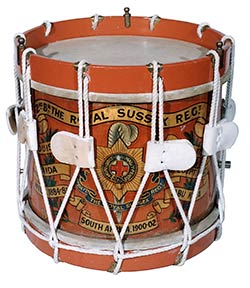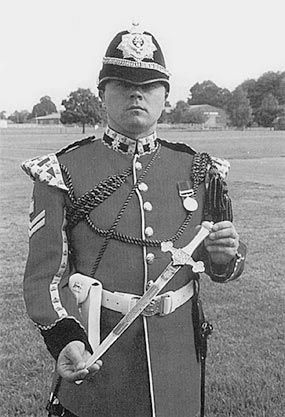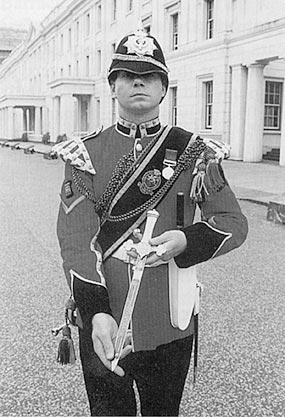Band and Drums Music
Drummers - Origins and Development
 The drum and fife, or flute, are among the oldest musical instruments. The drum had long been known in eastern countries and the early Egyptians combined the trumpet with the drum to provide their military music. The Greeks on the other hand favoured the flute. The forces of the Roman Empire generally used the trumpet while the ancient Briton preferred the horn and trumpet. These two remained the only instruments of martial music in England until the Crusaders returned from the East in the eleventh and twelfth centuries with small drums among their souvenirs of war with the Saracens. These drums were the precursors of what we now know as the side drum and the kettledrum.
The drum and fife, or flute, are among the oldest musical instruments. The drum had long been known in eastern countries and the early Egyptians combined the trumpet with the drum to provide their military music. The Greeks on the other hand favoured the flute. The forces of the Roman Empire generally used the trumpet while the ancient Briton preferred the horn and trumpet. These two remained the only instruments of martial music in England until the Crusaders returned from the East in the eleventh and twelfth centuries with small drums among their souvenirs of war with the Saracens. These drums were the precursors of what we now know as the side drum and the kettledrum.
With the drums came drummers from the east, who were musicians in the employ of great personages. As time went by these foreigners were replaced by native Englishmen whose importance grew in keeping with their widening duties. These were described before the days of a regular standing Army by Sir Ralph Smythe, a writer on military matters in the reign of Queen Elizabeth I:
'All captains (of companies) must have drums and fifes and men to use the same should be faithful, secretive and ingenious, of able personage to use their instruments and office, of sundry languages, for often they are to be sent to parley with their enemies, to summon (or surrender) their forts or towns, to redeem and conduct prisoners (of high rank) and diverse other messages which of necessity requireth language. If such drummers or fifers should fall into the hands of the enemy no gift nor force should cause them to disclose any secrets that they know. They must often practice their instruments, teach the company the sounds of the marches, alarm, approach, assault, retreat, skirmish, or any other call that of necessity should be known. They must be obedient to the commands of their captain and ensign (the bearer of the Company Colour), when as they shall command them to come, go, or stand, or sound their retreat, or other calls. Many things else belongs to their office, as in diverse places of this treatise should be said'.
There was thus much that the drummer could be called upon to do, ranging from his General's envoy to parley with the enemy to the less prestigious but vitally important role of 'company signaller'. The drum was the universal infantry means of conveying tactical commands to the men. With the fife it was also the means of regulating the soldier's day in camp long before soldiers had watches. While we know from other writings that the role of the drummer remained largely unchanged for another century, we can speculate that it was difficult to find men with the necessary skills and qualities whenever a mobilisation was ordered. By 1645, when Cromwell raised his New Model Army and instituted what later became the English regular Standing Army, the roles of envoy and signaller were separating. The drummer remained an important man who was lodged in the field adjacent to the officers, who was trained by a Drum Major, and who received a higher rate of pay then the soldiers. Establishments provided for a drummer and a fifer in each company of infantry. When battalions settled into the eight company system (which lasted more than two hundred years, until 1913), the established total of drummers came to 16. This has lasted until modern times though the strength has often been quite a different matter.
An orange drum of the 2nd Bn
The Royal Sussex Regiment.
(Click to enlarge)
By the late eighteenth century, new solutions to tactical developments were causing change for the drummers. While the bulk of the Foot Guards and Line fought in tightly controlled formation, the introduction of light infantry during the War of American Independence brought in a measure of independent action and dispersion. The drum would no longer do to convey orders and the bugle was introduced. Its use was confirmed and endorsed with the arrival of the Rifle Regiments in the Napoleonic Wars at the end of the eighteenth century. Yet despite the increasing noise of the battlefield and the growing numbers of units deployed, the 'heavy' infantry kept the drum. But by the Crimean War of the mid-nineteenth century, the lesson had been learned and the infantry drummer was equipped with a bugle as well as his drum or flute, and so it remained for tactical purposes until around 1914 and for ceremonial purposes to this day.
It was during the eighteenth century that battalion bands first began to be formed. But while drummers were 'field musicians' playing a vital part in the tactical employment and camp life of their company, the 'band of musick' was essentially an entertainment for the officers. They paid for it and overwhelmingly it was they who enjoyed it. All the musicians were civilians and the Bandmaster was often a foreigner. Even when bandsmen were enlisted later on and their role widened for the benefit of all ranks, their military training was restricted and their later tactical employment as stretcher bearers was more supportive than offensive. This marked the difference between bandsmen and drummers especially when, from the nineteenth century, the latter began to be brought together as a corps of drums. While not the standard formation in action it was a recognition of the value to morale at other times, and especially on the march, of the definitive and jaunty music of the drums and fifes.
Starting Young
"The Long and Short of it"
Bandmaster & Drummer Boy
(Click to enlarge)
Many drummers up until quite recent times began as boys. What is not so widely known is that from the eighteenth century onwards they served as boys suffering all the hardships and dangers of the ranks. There was no minimum age. All that was needed was adequate size and strength together with sufficient innate ability to learn the beatings, fingering or calls. Taught by the Drum Major, most youngsters learned by ear and played from memory. As the nineteenth century rolled on public conscience was stirred with two results; schooling was formally introduced and from 1844 a minimum age of 14 was laid down. But youngsters under the age of 17 continued to die and be wounded on service until 1900 when the essential difference between boy's service and man's service was finally fixed.
In the context of youth it is interesting to note that corporal punishment of soldiers used to be administered by drummers. Offenders could be sentenced to anything between 25 and 1,200 lashes and drummers were trained to carry this out in the approved manner. They also had a part to play in the ceremony of 'drumming out' a soldier whose offences had disgraced the battalion; towards the end of his ordeal, the offender was led through the ranks by a rope round his neck held by the youngest drummer boy who, when they got to the gate, sent the man on his way with a hearty kick to the rear. Flogging was stopped in 1881. But the caning of drummer boys by the Drum Major for minor offences carried on until it was abolished as late as 1950.
Uniform and Accoutrements
Drummers have always worn the uniform of their Regiment. When the heavy infantry wore scarlet, Regiments were distinguished on the collar and cuffs by their facing colour and, increasingly, by their badges. For a while from around 1751 to 1831, the drummers wore reversed colours, that is a coat of the facing colour with facings of scarlet. This was to help identify the location of the company commander in action and of the drummers themselves as the vital means of transmitting orders to the ranks. Along with the Regimental Colour, these splashes of facing colour also helped to identify the battalion to the formation commander and his staff. When reversed colours were abolished, a system of lacing jackets was introduced to mark drummers for much the same reasons from other soldiers. For infantry of the Line the lace used was of a design special to each Regiment and this lasted until the introduction ofthe universal 'crown and inch' in the 1870s. This is a heavy worsted braid featuring scarlet imperial crowns on a Gust off) white ground at Gust over) one inch intervals. It edged the collar and it covered the front and rear seams of the arms and all the seams of the back of the tunic. Another pattern of red and white braid edged the cuffs and the shoulder straps. Two additional features of dress special to drummers were the 'wings' or curved pieces of scarlet cloth edged and crossed with braid which covered the arm holes at the shoulder, and the drummer's sword which was carried in one form or another from 1857 to the early 1900s. This weapon was given up at the same time as tactical considerations finally removed the drum from the battlefield and equipped the drummer for the first time with rifle and bayonet. Very interestingly, the sword has lately been revived by the Army as a prize for outstanding non-commissioned officer drummers. Instituted in 1997, a Drummer's Sword given annually by the Worshipful Company of Cutlers is awarded by the Director of Infantry and has been won in its first two years by young NCOs of the Princess of Wales's Royal Regiment, Lance Corporal Fuller in 1997 and Corporal Foy in 1998. They are required to wear their swords when clothed in the full dress uniform of a drummer.
The Drum Major
Most Line infantry battalions gained a Drum Major for the first time about two hundred years ago; some had them earlier. Ranking as a Sergeant, the duties of this personage were to instruct and train the drummers and to ensure that their performance accurately and effectively met the demands of battlefield and camp. Later, in the nineteenth century, the Drum Major ranked and was dressed as a Staff Sergeant, whatever his actual rank. This placed him only one grade below the (Regimental) Sergeant Major and on a line with the (Regimental) Quartermaster Sergeant. Until the early part of the twentieth century they shared the same badge, four chevrons inverted with above them a star for the RQMS and a drum for the Drum Major. This remains his badge in full dress today, no other being necessary in view of his prominent role and gold embellished uniform.
Over his full dress uniform the Drum Major wears a coloured belt (sometimes called in error a 'sash'). This is an authorized distinction provided at public expense but a plain one. In its place most battalions today have a privately provided belt which is extensively embroidered with badges and battle honours but shares, or should share, with its issue equivalent three features: a ground of the Regiment's facing colour, a pair of miniature drum sticks, and the cypher of the Sovereign. The Drum Major also carries a Staff, a term which is an abbreviation of 'Leading Staff. It is a functional object used to signify the leading position of the Drum Major on the march (and perhaps to clear the way) and to give visible instructions to the drummers or musicians behind him. It is not a mace. Like a belt, a Staff is provided to each battalion at public expense though some Regiments have their own, often ornate, presentation ones.
The Drums Today
The scarlet full dress of a pre-1914 drummer is today worn on grand parades and public occasions by drummers of most infantry Regiments. It is described above and completed with the blue home service helmet with its brass (now gilt plated) fittings and large star plate. With the loss of Regimental bands in 1993, it falls to the drummers of a battalion almost alone to bear and display for all to see the honours and distinctions of their Regiment. The Colours appear all to infrequently while any form of uniform with bright and visible badges and embellishments is a rare sight in place of the ubiquitous combat dress.
During the twentieth century drummers have been 'company signallers', then formed the battalion headquarters defence platoon, then a platoon in a rifle company or the assault pioneer platoon, then the machine gun platoon and are now in the process of changing once again to a rifle platoon. The Drum Major has usually been the platoon commander and he with all his NCOs and drummers must earn their promotion as much by their military skill and leadership as by their musical ability. Whatever their tactical role, it comes fIrst. Their drumming skills, their dress and turnout on all occasions, and their collective style and panache as the living representation of the origins and traditions of their Regiment, all come second. Much of their duty as drummers and a very large amount of their training is carried out in their own time after their duties as infantry soldiers are complete. Their only reward for all this extra work which is so essential to the morale and effectiveness of the battalion is their own pride in a job well done and the appreciation of their colleagues, especially the approval of their Commanding Officer. On him almost alone falls the duty of preserving, sustaining and making proper and effective use of the Drums. Long may he do this and long may the Drums prosper!
The Director of Infantry's Cutlers Sword Competition
The original idea for this competition came from The Corps of Drums Society, but took some years to become a reality. The Worshipful Company of Cutlers of the City of London have generously agreed to present a sword annually and Headquarter's Infantry promote it and provide the administrative support.
Colonel P Walton
As mentioned previously the first two winners of this prestigious award were Lance Corporal Fuller of 1 PWRR in 1998 and in 1999 Corporal Foy of 2 PWRR. The presentations on behalf of the Director of Infantry was made by Colonel AC Mievelle OBE the last Commanding Officer of 1st Bn The Queen's Regiment.
Lance Corporal Fuller 1PWRR 1998 | Corporal M Foy 2PWRR 1999
(Click to enlarge)
Drummers Swords
 |
| Drummers Swords (Click to enlarge) |
A Royal Warrant of 1768 decreed that drummers and fifers should have a short sword with a curved scimitar blade, but in 1802 this was changed to a straight blade, 24 inches long, with a brass hilt similar to that worn by Sergeants at the time. In 1856, after the Crimean War, a completely new type of Drummer's sword was introduced, being the Drummer's Sword Mark I. This weapon, which was more ornamental then useful, had a straight double-edged blade, 19 inches long with a 'gothic' style cross-hilt carrying the Royal cypher 'VR' in the centre. For Drummers the hilt was made of brass, while for Buglers of the Rifle Regiments it was made of cast iron. The scabbard was of black leather with brass fittings and it was carried in the same buff leather frog that was used for the bayonet.
In 1895 the Mark 11 sword was introduced with a shorter blade of 13 1/2inches, and with a less elaborately decorated hilt. Once again there was an iron hilted version for Buglers, and both types are shown in the illustration below. This sword was of even less practical use than its predecessor and it is doubtful if it was ever used on active service, except perhaps for opening tins!
The swords ceased to be issued in 1905, though it is believed that some regiments have managed to retain them
Related





